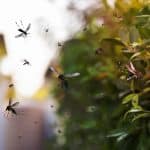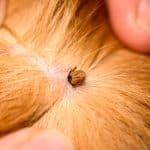Red Wasps and Yellowjackets… while they both may be wasps in a general sense, they are two very different insects. Although they may be different, can you tell the difference between the two? Do you know how to identify them, where they like to habitat? How you can know when you are seeing a red wasp nest or a yellowjacket nest? How they are alike and how they differentiate? Which of the two or more aggressive or do they have the same amount of aggression? You will know so much more about the two different wasps once you’ve read this; you never know how helpful it will be to know all of this information.
Some people think that all wasps look the exact same, but this is far from the truth. If you happen to see either the red wasp or the yellowjacket there are specific things that you need to look for to be able to distinguish which it is? The red wasp is red all over its body and it has purple-black wings… it’s about an inch long in size. On the other hand, yellowjackets are about half an inch long in size. They are black and yellow, which can oftentimes have them misconstrued as bees; they do have alternating bands of black in yellow in the middle of their bodies but they don’t have tan hair that covers their body as bees do. Their stingers are barbed and they are known to sting you repeatedly and not just once.
The habitat for the red wasp happens to be throughout the eastern and central areas of the United States. Yellowjackets dwell in habitats that are across North America… they prefer to be in orchards, meadows, and woodlands… you may often see them in suburban or urban settings such as the playground or cemeteries.
You may see a yellowjacket nest often and not know it. They will just about always have their nests built in a hole that you will see in the ground. Sometimes the yellowjacket nest can get to be the size of a basketball. The nest of a red wasp is a paper-like structure that is made from plant materials and wood that are first chewed and mixed with the saliva from the wasp. Attached to the nest is a small stem… it’s there to support the nest cells that are within the nest itself.
There are ways in which the red wasp and the yellow jacket are alike and how they differentiate. The following shows how the red wasps are much different from the yellowjackets.

* A red wasp has its nest suspended; the yellowjacket is subterranean
* There are usually less than 100 red wasps in the nest; yellowjackets generally have well over 100 wasps in their nests
* Red wasp prey on live insects, while yellowjackets scavenge dead insects and sugars
* A red wasp nest is open and in the shape of an umbrella; the yellowjacket nest is an enclosed one with a paper comb style
The ways in which they are the same include:
* They both have to build nests every year
* The only ones that survive throughout the winter are the pregnant females
* Each of their colonies has a queen mother, many sterile female workers, and males
* They can both deliver a poisonous sting
Knowing so much about the two wasps, you may be curious to know which of the two is the most aggressive one. Yellowjackets are very eager to sting; they seem to be very aggressive especially when they feel they are under attack or if their nest is under attack (which can seem like it’s often being that it’s on the ground). Red wasps are not aggressive at all… they will generally sting you if they feel they need to defend themselves. If you are actively disturbing the nest of a red wasp or if you are swinging at it, it feels like it needs to sting you to cause you to stop. Yellowjackets are more aggressive than the red wasps are.
At Emtec Pest Control, we are committed to safe and responsible pest control. We understand that your family’s safety is your number one priority, so we make it our priority, too. If you have any other questions about any of these pests or pest control for your home or business, contact your Oklahoma pest control experts at Emtec Pest Control by calling us or by filling out our online contact form. Our service areas in Northeast Oklahoma include Bixby, Broken Arrow, Catoosa, Owasso, Jenks, Sand Springs, Sapulpa, Skiatook, Stillwater, Tulsa and the surrounding areas. In Central Oklahoma, we service Edmond, Moore, Oklahoma City, Yukon and the surrounding areas. You can also connect with us on social media for more helpful pest control tips and information. We are on Facebook.-





